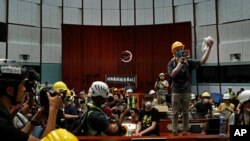As the shocking scenes at the U.S. Capitol building unfolded last week, residents of Hong Kong, nearly 13,000 kilometers away, were reminded of the chaos at their own Legislative Council on July 1, 2019.
It also was an unprecedented moment, and a turning point, for the pro-democracy protests in the city were then just one month old.
July 1 is a significant date in the Chinese city. It’s the anniversary of Hong Kong’s handover to China by Britain in 1997 and has attracted annual rallies since. But in 2019, there was a different reason people were taking to the streets. They were challenging a controversial bill that would allow extradition of Hong Kong residents to mainland China for trial. Demonstrations had been gathering momentum since June.
As street protests ensnarled government buildings that day, groups of activists splintered off from the masses, headed towards the Legislative Council, the city’s top political chamber.
The demonstrators eventually entered the complex by breaking glass walls and metal doors, as local police refrained from confrontation. Protesters swarmed the chamber, waved both the Union Jack, Britain’s national banner, and the old colonial Hong Kong flag.
Slogans were spray-painted, and furniture and pro-Beijing portraits were damaged, but it was reported that protesters made efforts to protect cultural objects and literature.
According to the president of the Legislative Council the total damage was about $5 million. Overall, 13 people were arrested, 15 were injured, and there were no fatalities.
Beijing and its supporters, including Hong Kong Chief Executive Carrie Lam, condemned the events at the Legislative Council as “riots,” with the narrative focusing on “violent protesters” who vandalized the complex. Despite the rhetoric, a week later, Lam gave in to pressure and announced the extradition bill was “dead.”
But the pro-democracy protesters felt they had made statement, attempting to maintain Hong Kong’s limited democracy, and resisting the city’s continuous slide into China’s authoritarian system.
Even today, water barriers still surround the government complex as a vivid reminder of the day’s historic events.
Hong Kong was to have been under a “one country, two systems” agreement until 2047, made between Britain and China prior to the handover of the city in 1997. This allows Hong Kong to enjoy limited autonomy and democracy. But Hong Kongers have complained these freedoms are being eroded by Beijing.
Beginning in June 2019, street demonstrations surged through the former British colony for six consecutive months, often turning violent. In June 2020, Beijing enacted a national security law on Hong Kong, prohibiting subversion, success, and foreign collusion, with violations of the law freely interpreted.
Since Wednesday’s chaos in Washington, Chinese Communist Party officials and those affiliated have made public comparisons between the incidents at both the U.S. Capitol and the Legislative Council.
Hua Chunying, China’s Foreign Ministry Spokesperson tweeted a video clip of events on 1 July 2019 in Hong Kong with a title “Mobs storm Hong Kong’s Legislative Council” in an apparent jibe towards Washington.
Qingqin Chen, the chief reporter for China’s state-affiliated media Global Times, tweeted: “When Trump supporters storm Capitol, they are called as ‘mob’ but we’ve seen exactly the similar scenario happened in #HongKong #LegCo in 2019.”
The linking of the two incidents has raised an uproar on social media, with residents and reporters in Hong Kong angrily insisting the incidents are not comparable.
Self-exiled Hong Kong activist Nathan Law, who graduated from Yale University, tweeted about such comparisons.
“It’s the WRONG comparison. Several scenes on 1st July 2019, one of the monumental days of the protest movement, can help you tell the differences,” he said.
The tweet continued: “The protesters had a very clear understanding of what they were targeting, they only damaged the symbols representing the authoritarian regime.” Law added, “The protesters who entered the building were civilized and well-mannered. They were fighting for a better society and social justice. They were demanding an unelected government to implement a fair and open electoral system.”
Several pro-democracy protesters within Hong Kong also spoke to VOA, giving their reaction.
Twenty-seven-year-old Hong Kong resident Aaron -- who asked that only his first name be used, for fear of being arrested -- said “Beijing has always played a game of ‘whataboutism’ when it comes to international politics. Trying to deflect their own internal events but pointing out the failings in other countries.”
Aaron added: “From a distance, I can see that a casual observer will be quick to draw comparisons between the two while failing to understand the nuance between people protesting a non-democratic single-party government like that of Hong Kong and China and protesting a legitimate democratic electoral result like in the U.S.”
For the Hong Kong protester, “there isn’t even a democratic process to scrutinize,” Aaron told VOA.
Another Hong Kong resident, Anson – who asked that his real name not be used -- said it’s “absolutely ridiculous” both incidents have been compared and the comments by China “highlights their narrow view of democracy.”
Anson told VOA, “The so-called ‘storming’ of the LegCo occurred as a reaction to an unjust bill issued by the Hong Kong government to further hinder the advancement of basic human liberties in Hong Kong. The U.S. Capitol siege was in reaction to (a) legitimate and democratic election. The simple difference is the people of Hong Kong were not even given a chance to decide for their futures, so they were forced into action.”




